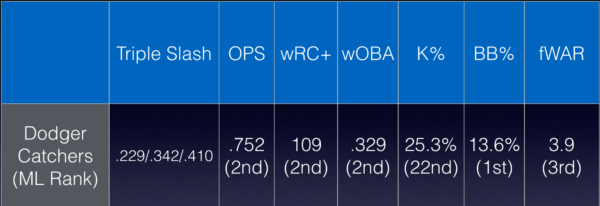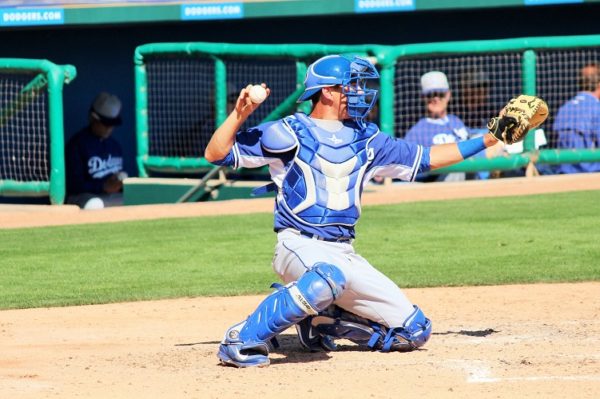We’re on to position players in our position-by-position 2018 recap series (shouts to Allan for handling the relief pitcher one). Here goes the only recap remaining that won’t include Enrique Hernandez.
——
Previous Entries
——

Coming off the 2017 postseason, there were questions about who the Dodgers’ starting catcher should be in 2018. In Dustin’s offseason plan he proposed trading away Yasmani Grandal, who was coming off an abysmal postseason. Chad wondered if there was value in moving Grandal, and it ended up being quite a good thing that Grandal remained in Dodger Blue. Dustin also proposed trading Pedro Baez. Why does Dustin hate the Dodgers?
Yasmani Grandal
2018 stats: .241/.349/.466, .815 OPS, 125 wRC+, .352 wOBA, 23.9 K%, 13.9 BB%
Recency bias is a very real thing. Fans suffer from it, and apparently MLB front offices do as well.
Grandal was one of six major league catchers with enough plate appearances to be a qualified batter. 27 catchers had at least 300 plate appearances. Among those, Grandal ranked in the top five in each stat listed besides batting average and strikeout rate. Grandal is pretty easily one of the best offensive catchers in baseball. He showed that last season, as he caught over 70 percent of the Dodgers’ innings and put up some of the best catcher rate stats in the league. His 24 dongs were the fourth-most on the team and the second-most among all catchers.
Defensively, Grandal was still mostly fine for most of the season. He caught the fourth-most innings among all catchers (1037 1/3) and despite a perception that he’s a catcher that cannot catch the ball, his nine passed balls were the ninth-most in baseball, fewer than seven catchers that caught fewer innings. Baseball Prospectus ranked Grandal as the second-best pitch framer in baseball last season with 17.7 Framing Runs Above Average.
While Grandal’s final numbers were excellent, he still struggled mightily with consistency. He posted OPS’s above .800 in March/April, July and September/October. In all the other months, Grandal posted OPS’s below .700, including a .521 OPS in June (more than .100 lower than Clayton Kershaw and Hyun-Jin Ryu‘s season OPS).
While Grandal ended the regular season on a strong note, that success did not carry over into the postseason. There’s a real, non-hyperbolic chance that Grandal turned in the worst postseason in recent MLB history. After an 0-for-4, three strikeout game in Game 1 of the NLDS, Grandal hit a solo dong in Game 2, giving the Dodgers a third run in their 3-0 victory. Grandal drew three walks in Game 3, and then things really bottomed out.
Grandal had 23 plate appearances, starting with Game 4 of the NLDS. He reached base five times and struck out 12 times. He only had 23 plate appearances because he lost his playing time in the NLCS. In Game 1, Grandal allowed two passed balls, was called for a catcher’s interference, and failed to field a throw from the outfield, allowing two runs to score. In Game 3, Grandal failed to field another throw from the outfield and allowed another passed ball. Grandal only started one of the remaining nine postseason games behind the plate, and while he really only had like four tragic innings, he didn’t provide anything offensively or defensively.
The current state of free agency, coupled with Grandal’s lasting impression led to him signing a one-year, $18.25M contract in Milwaukee with a mutual option for 2020. Surely not the type of contract that a Top 3 (at least) catcher deserves, but it’s what he got.
Austin Barnes
2018 stats: .205/.329/.290, .619 OPS, 77wRC+, .281 wOBA, 28.2 K%, 13.0 BB%
Coming off an excellent 2017, some thought that Barnes would slide in nicely as the Dodgers’ new starting catcher. While he got plenty of playing time against left-handed pitchers early on, Barnes was mired in a season-long slump. Barnes posted an OPS above .700 in only one month during the regular season (September/October), as he hit three of his four homers last season during the final month.
Barnes was bad and really didn’t look like the same player as 2017. His walk rate fell nearly two percentage points. His strikeout rate nearly jumped 12 points. For all the talk about Grandal being the “three true outcomes” guy and Barnes bringing quality plate appearances, Grandal brought better plate appearances than Barnes in 2018. Last season, Barnes swung at more pitches out of the zone (20.5 percent compared to 17.4 percent in 2017) and fewer pitches in the zone (52 percent compared to 58.4 percent in 2018). Barnes was swinging at fewer good pitches, and when he did make contact the quality of that contact faltered. After a 36 percent hard-hit rate in 2017, Barnes posted a 29.9 percent hard-hit rate in 2018. In 2017, he averaged a 9.6 degree launch angle. In 2018, that fell to 4.4 degrees. Sometimes, a player gets unlucky. Barnes was genuinely bad at the plate last season, and his numbers reflected that. This doesn’t mean he’s a bad player and his true talent level probably sits somewhere between his 2017 and 2018 seasons at the plate.
Barnes was still solid behind the plate. His 10.1 Framing Runs Above Average was the 12th-best in baseball. He caught only five of 23 potential base-stealers, but allowed only one passed ball in 434 2/3 innings behind the plate.
Despite his season-long struggles, Barnes started more postseason games than Grandal. He started nine of the 11 games following Grandal’s disastrous NLCS Game 1. He was somehow worse than Grandal at the plate, registering two hits (both singles) in 32 plate appearances in the postseason with 14 strikeouts.
Rocky Gale
2018 stats: .000/.000/.000, .000 OPS, -100 wRC+, .000 wOBA, 50.0 K%, 0.0 BB%, 0.0 fWAR
That felt mean. I needed more words. Gale had two plate appearances. He struck out once.
 Dodgers Digest Los Angeles Dodgers Baseball Blog
Dodgers Digest Los Angeles Dodgers Baseball Blog
